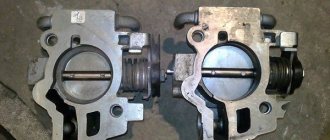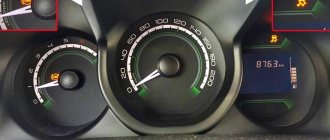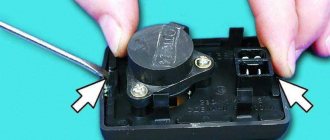The stove belongs to the heating, air conditioning and ventilation system of a car. The purpose of its work is to maintain a given temperature and humidity conditions, ensuring comfortable conditions for being in the car and an influx of fresh air. The type of ventilation system in Grant is supply and exhaust. The stove is controlled by simple controls that allow you to change the speed of air flow, its temperature and the direction of blowing: onto the windshield, into the legs, etc. To isolate the interior from unpleasant odors and faster warm-up in winter, an air intake switch for the stove is provided from outside or from the inside.
Interior ventilation
To ventilate the interior, set the ventilation and heating control unit controls to the following positions.
- Turn control knob 2 to the minimum temperature position (see Fig. 1 and 2).
- Place the regulator handle 4 opposite the pictogram.
- Open the nozzles on the instrument panel.
- Set the desired air supply speed with switch 1.
- If the windshield fogs up, set the regulator handle 4 opposite the pictogram.
Thermostat
One of the most important elements of the SOD is the thermostat. It is he who is responsible for the temperature of the coolant. A working thermostat heats the coolant to a temperature of 85°C. If it is jammed in the open position, the coolant will constantly circulate through the cooling radiator, preventing the car from warming up, which will lead to a low coolant temperature and, consequently, insufficient heating of the interior in cold weather.
Preventing glass fogging
When the air humidity is high (during heavy rain), the car windows may fog up. To prevent the windshield and front door windows from fogging up, do the following:
- Turn regulator handle 2 to the middle position.
- Place the regulator handle 4 opposite the pictogram.
- Move switch 1 of the electric fan operating modes to position “2”.
- To prevent the rear window from fogging up, press the button in the 3-button switch block.
Quick heating of the interior
To do this, do the following:
- Turn control knob 2 to maximum heat.
- Place the regulator handle 4 opposite the pictogram -
- Switch the operating mode switch 1 of the electric heater fan to position “3”.
- Open the side and center vents on the instrument panel.
- Set lever 5 to the extreme right position - no outside air enters the cabin (recirculation mode).
WARNING
[td] It is not recommended to use the recirculation mode for a long time while the vehicle is moving, as this usually leads to fogging of the windows.
Heat exchanger Grants
The purpose of the radiator of this car is to heat the air that enters the cabin with heat from the liquid that cools the car engine. The heat exchanger is connected to the motor: hose - 2 pieces (located in the engine compartment).
The radiator itself is installed in a plastic housing. The entire structure is located in the central part of the dashboard.
Heating and ventilation system on Lada Granta, design
- radiator;
- several air ducts: to the glass blower grilles, to the right, central and left deflectors;
- Control block;
- radiator cap;
- air duct;
- seal;
- stove body;
- a hole connecting the air duct to the rear passengers;
- fan;
- fan housing;
- damper drafts: recirculation, temperature controller, air flow distribution;
- Fan resistor is optional.
We carry out diagnostics
If it is cold outside and the interior cannot warm up properly, then you need to check the operation of the cooling system, which has a direct effect on heating the interior.
Coolant level
To do this, you need to open the hood and, with the engine not warmed up, check where the coolant is located.
If its level in the tank is between the minimum and maximum marks, then everything is in order. But, when this level decreases, problems with the tightness of the cooling system are possible, and this leads to a decrease in pressure inside the system. If the problem is not corrected, the stove will not be able to warm the air in the cabin effectively enough.
Thermostat
This is a native Luzar thermostat
We are talking about the possible sticking of the thermostat valves in a position where the coolant circulates only in a larger circle. So, during the cold period, the coolant will not warm up to normal temperature, and therefore the interior will not become warmer.
Thermostat location under the hood
You can verify the presence of this particular breakdown by the fact that the car, while stuck in traffic jams, begins to overheat very quickly. In addition, when moving along the highway at a stable speed, the engine loses its temperature too quickly, if we talk about the cold season. However, even if these “symptoms” are not observed in your car, this does not mean that the thermostat is working properly. It is quite possible that its defect lies only in tangible problems with the interior heater.
For even more complex cases, you can check the pipes that connect to the heater radiator. Normally, one should be hot and the other just slightly warm. If the second of the pipes is very cold, this will indicate that the stove radiator in your car is clogged. It won't be easy to clean it. Most likely, you will have to completely remove the entire stove.
Reviews
| № | Positive |
| 1. | Vladimir: Six months have passed since we bought the car, and there have been no breakdowns in such a short time. The fan refused to start several times, the reason turned out to be a bad fuse contact. |
| 2. | Vasily: I have been actively using the machine for two years, there are no particular complaints, all units are working as normal. Breakdowns happen, like everyone else, but they are minor and can be easily fixed on your own. |
| 3. | Gennady: after two months of the machine being idle, the stove heater began to supply little air. I disassembled it myself, cleaned it, works properly. My recommendations to car enthusiasts: don’t be afraid to repair them yourself. |
| 4. | Kirill: I think that Granta is put together with high quality, the price is affordable for a family with an average income. Provided timely maintenance, no problems arise. |
| 5. | Ivan: after buying the car, I immediately drained the factory antifreeze and bought good imported antifreeze. Now I don’t know any grief, the stove works like a charm. |
| 6. | Dmitry: there were minor defects, I fixed them myself, but they were insignificant and did not affect the performance of the machine. |
| 7. | Igor: I’m happy with the car, there are no major comments, as for domestic transport it’s very good. |
| Negative | |
| 1. | Victor: Over the two years of active use of the car, I contacted the service station several times under warranty. The fan malfunctioned, then the stove heater. Decided to renovate and sell. Renault Logan is several times better than its domestic counterpart. |
| 2. | Vladlen: I’m dissatisfied with Grant’s purchase, I’ve already regretted wasting money several times. The car is not worth the investment. |
| 3. | Gennady: a year and a half since purchasing the car, constant investments, purchase of consumables, repairs at service stations. |
Conclusion The stove heating system of the Lada Granta is completely copied from the Lada Kalina. There are no complaints about the equipment, everything works properly. In order for the mechanism to serve for a long time, it is necessary to systematically carry out inspection and prevention.
Many motorists save on maintenance, as a result of which the service life is reduced. An important factor is the cloudiness of the antifreeze. The manufacturer recommends replacing it every 75,000 km. Exceeding the interval causes deposits to form at the bottom of the radiator and corrosion begins.
Removing the heater control unit
Removing the instrument panel trim, article - How to remove the central trim of the instrument panel Lada Granta
Using a screwdriver, press out the two clamps of the shell tip holder (the clamps are shown by arrows)
Remove tip 2 of the damper rod shell from holder 1 on the heater body
Using pliers, we recess the traction lock on the damper drive pin
Remove the black rod from the recirculation damper drive
We also remove the blue rod from the temperature regulator damper drive, the green and yellow rod from the air distribution damper drive
Remove the control unit with rod assembly
Appearance
The body design emphasizes the dynamics and off-road qualities of the LADA XRAY CROSS. Sloping headlights, curved grille fins, an aggressive bumper and signature chrome trim create an X-shaped styling. The side of the car is decorated with expressive lines on the wheel arches and sporty wheels.
The “Cross” version is distinguished by a plastic body kit around the entire perimeter of the car, a massive bumper with larger and more aggressive air ducts and roof rails. At the rear there is an expressive and more brutal bumper made of black plastic with a silver trim. The dynamic image of the new LADA XRAY CROSS is completed by a dual muffler pipe and a shark fin-shaped antenna on the roof.
Heating system control
To control the speed and direction of incoming air, the car has switches with special marks. With their help, you choose what kind of air the heater should blow: cold or hot.
It should be noted that each of the above components occupies a significant place in the entire heating system. If at least one of them fails, the others will not be able to function normally. Each pipe and tube, small seal or large radiator is a complete, thoughtful and mutually supporting system that requires proper operation and regular maintenance.
Components of an air conditioner
The thermostatic valve is located in the evaporator housing and is designed to reduce pressure. This phenomenon causes the refrigerant to boil in the evaporator. It should be noted that the device does not require configuration.
As for the receiver-dryer, this unit is used for liquefied refrigerant purification. Filtration is carried out using silica gel. Long-term depressurization of the air conditioning system requires replacement of the device. This is due to the fact that the dehumidifier in the Frost model, after refueling the system, is not able to fully perform its functions. The result can be the formation of acids and their destruction inside the air conditioning system.
The components of the structure under consideration are connected to each other by a pipeline. This product is made of aluminum alloy and has a single sealed circuit. During the operation of the vehicle, it is recommended to avoid possible dents or scratches on this pipeline. The moving elements of the air conditioner are connected to each other by special flexible inserts made of synthetic raw materials. These inserts can withstand pressures up to 30 bar. Each rubber pipeline connection is equipped with rings that are designed to improve sealing. It should be noted that these rings are disposable, so they require replacement when dismantling or disconnecting pipelines and inserts.
Rules for using a standard heating system
The car's operating manual outlines the basic principles of operation of the ventilation, air conditioning and interior heating systems. To quickly warm up, you need to switch the damper to the air recirculation position and the fan speed to the “maximum” position. In this case, the car windows must be closed. You should not drive in this mode for a long time, as this can lead to fogging of the windows.
The main reason for the accumulation of condensation is the difference in temperature inside and outside and high humidity. To prevent the windows from fogging up, you need to warm them up by pointing the heater deflectors at them and dry the air by turning on the air conditioning. However, when the vehicle is driven under heavy loads (for example, on long climbs) with the air conditioning turned on, the engine may overheat, so in such conditions it is necessary to monitor its temperature. Condensation is usually the result of luggage blocking the vents.
Incorrect operation of the ventilation and heating system may be caused by a malfunction of the temperature sensor located in the interior lamp. It is not recommended to drive with the windows open in hot weather with the air conditioning running.
The vehicle's ventilation, air conditioning and heating system creates conditions for normal and comfortable driving in any climate zone. AvtoVAZ engineers developed and implemented a simple and reliable heating concept for the Lada Granta model. But for the system to operate effectively, certain rules must be followed, which will help avoid unexpected breakdowns.
How does a stove fan work?
The main task of the fan is to take air flow from the outside and deliver it to the deflectors.
The fan is activated by a mechanical button, to which a 12 V power supply is supplied. In the Lada Granta version, the fan operates at one of three speeds. The driver selects the most optimal mode depending on the temperature inside the cabin.
Additional resistors Grants
Without resistors, the fan operates at one speed with a stable rpm. There are a total of 3 resistors installed on the board.
When the lever is moved to the first position (three resistors), the fan rotates at the first speed, the very minimum. Transfer to the second position - second speed (two resistors). Transfer to third - third speed (one resistor). The detailed diagram of the stove is shown in the photo.
Air distributor flap
Installed to regulate the air flow coming from the fan to the glass for blowing through air ducts.
Often, deformation and bending of the plastic body under the influence of temperature leads to flow leakage and depressurization.
Temperature control flap
Regulates the supply of warm air flow from the stove heater to the car interior. The wider the damper is open, the greater the throughput of the “channel”, and vice versa, the narrower it is, the less.
Heat exchanger Grants
Its main purpose is to heat the air flow entering the cabin. The heat exchanger is connected to the power unit through two rubber pipes: supply and return for fluid circulation.
The standard location is the central part of the dashboard of the car interior.
Air temperature sensor inside the car
Structurally installed inside a plastic interior lighting lamp. To avoid overheating, the sensor is equipped with a forced airflow system.
The installation is designed so as not to distort the actual temperature readings.
Pipes
Rubber pipes literally permeated the entire cooling, stove heating, and air conditioning system. Without their help, it is impossible to connect sections of highways with each other. Fixation method: with clamps, metal ties.
Why is it cold in Grant
Introduction
Lada Granta is a domestic car produced to this day. Granta is one of the affordable cars on the market and meets all the requirements for ensuring comfort for passengers and the driver. This car is equipped with air conditioning and climate control, although not full, but with a hint of it. With the onset of cold weather, it happens that the stove in Grant begins to blow cold air, and in order to find and eliminate the cause, you can spend a lot of effort without knowing the essence of the design and the causes of this breakdown.
This article will talk about the reasons why the stove in Grant blows cold air. After reading the article, you can easily find the cause of the breakdown and fix it.
Possible causes of failure
There are several similar reasons why the interior heater suddenly or after summer begins to work ineffectively. Below is a list of reasons:
- The antifreeze level has dropped;
- Cabin filter clogged;
- Heater radiator clogged;
- The expansion tank cap is faulty;
- Thermostat jammed;
- Damper jamming;
To understand each possible reason, it must be considered individually.
Antifreeze level drop
The amount of antifreeze directly affects the operation of the heater. If the level in the expansion tank drops, the cooling system may catch an air lock during circulation, which will lead to insufficient heating of the heater radiator and, consequently, to insufficient heating of the interior in cold weather.
It is necessary to check the antifreeze in the engine compartment of the car; to do this, you need to look at the expansion tank and the liquid in it should be between the MIN and MAX marks. If the level is insufficient, the coolant must be added, observing the color of the antifreeze.
Cabin filter
The cabin filter is responsible for the frequency of the air ducts, protecting the fans and radiator from contamination. Often, many car owners remove the cabin filter to create a more powerful air flow from the air ducts, which soon leads to contamination of both the air ducts and the radiator with fan.
If there is a weak air flow from the heater, then most likely the cabin filter or heater radiator is dirty.
Heater radiator
The radiator is the heart of the stove in a car, it is it that gives off heat to heat the interior; the hotter the radiator heats up, the warmer it will be in the cabin. When the radiator becomes clogged, heat is transferred much worse due to poor fluid circulation through the system.
Radiator clog can be of two types: internal and external.
Blockage outside
Such blockage most often occurs due to the absence of a cabin filter or due to its long use without replacement. This problem can be resolved by removing and washing the radiator.
Blockage from inside
The blockage that forms from the inside is due to the accumulation of oxides formed due to the oxidation of aluminum. Also, if the antifreeze is not changed for a long time, it can deteriorate and precipitate, which will soon clog the radiator.
Check the radiator for clogging from the inside, you can assess the reliability of fluid circulation through it. To do this, you need to touch the hoses that go to the radiator; they should both be hot. If any of them are cold, the radiator is clogged and needs to be washed.
Extender cap
The expander cap is a reliable element, but it can also fail and impede the circulation of fluid through the system by creating a vacuum. The lid is a valve that opens and closes as necessary to supply the expander with air, which helps prevent vacuum from forming in the system. If the valve jams, a vacuum will be created in the system, which will lead to poor fluid circulation and insufficient heating of the interior.
Thermostat
One of the most important elements of the SOD is the thermostat. It is he who is responsible for the temperature of the coolant. A working thermostat heats the coolant to a temperature of 85°C. If it is jammed in the open position, the coolant will constantly circulate through the cooling radiator, preventing the car from warming up, which will lead to a low coolant temperature and, consequently, insufficient heating of the interior in cold weather.
The damper in modern cars is controlled both by actuator and mechanically. It happens that the damper gets stuck in the open position and directs the air flow past the radiator, which produces cold air at the outlet of the air ducts.
How to change a heater
Replacement of the Lada Granta stove is carried out in accordance with the technological regulations of the manufacturer. But experienced car enthusiasts offer their own schemes for replacing this device, which are successfully used during repair work. First, you need to clear the space under the hood of the car: unscrew the battery terminals and bolts and remove it, remove the throttle body pipes, air ducts, and remove the air filter. After this, you can drain the antifreeze from the engine cooling system.
Work in the interior begins with dismantling the decorative cover of the handbrake: you need to unscrew two screws and release the tunnel fastening on the driver and passenger sides. Now you need to remove the gas pedal by unscrewing three bolts and disconnecting the contact group. Then you should remove the brake pedal mounting pin and press on it, freeing up space for further work. To access the heater radiator, remove the plastic side cover of the dashboard. To dismantle the heat exchanger, cut the pipes in two places.
The cut-off part of the pipes should be pulled out into the engine compartment, then bend the brake pedal and pull the old radiator into the cabin. After installing the new heat exchanger, its pipes are pushed into the cabin from the engine compartment, put on the radiator pipes and securely tightened with new clamps. Further installation of the removed parts occurs in the reverse order. Then the battery is installed and coolant is added.
Design features of the LADA Granta engine cooling system
The LADA Granta engine cooling system is liquid (with forced circulation of liquid), sealed, with an expansion tank. The system is filled with ethylene glycol-based coolant (antifreeze), which does not freeze at ambient temperatures down to -40 'C. The design of the cooling system of all engines installed on Lada Granta cars is fundamentally the same and is described using the example of a car with a VAZ-21116 engine.
Location of elements of the LADA Granta cooling system:
A centrifugal water pump provides forced circulation of fluid in the cooling system of the Lada Granta, is installed on the front plane of the cylinder block and is driven by a timing belt. The pump has sealed bearings that do not require replenishment of lubricant. The pump cannot be repaired; if it fails (liquid leakage or bearing damage), it is replaced as an assembly.
A thermostat with a solid heat-sensitive filler maintains normal operating coolant temperature and reduces engine warm-up time. The Lada Granta thermostat has a main and additional bypass valve. At a coolant temperature of up to (85±2) °C, the thermostat is completely closed and the liquid circulates through a small circuit, bypassing the radiator, which speeds up engine warming up. At temperatures above 85 C, the thermostat begins to open, and at 102 ° C it opens completely, ensuring fluid circulation through the radiator. An electric fan with a plastic impeller ensures air purging of the radiator at low vehicle speeds, mainly in urban conditions or on mountain roads, when the oncoming air flow is not enough for cooling the radiator. To increase operating efficiency, the fan is installed in casing 7 and attached to it at three points through rubber pads. The casing, in turn, is attached to radiator 3 at four points. The electric fan is controlled by the engine control unit, which receives information about the coolant temperature from sensor 5 (see Fig. 1), located in thermostat socket 4.
The radiator is tubular-plate, aluminum, with plastic tanks, two-way, with a partition in the left tank. At the bottom right there is a drain plug 6. The tanks contain inlet and outlet hose pipes to the engine water jacket, as well as a hose pipe connecting the radiator to the expansion tank.
The expansion tank serves to compensate for the changing volume of coolant depending on its temperature. The tank is made of translucent plastic. The “MAX” and “MIN” marks are applied to its walls to control the coolant level; on top there is a filler neck, hermetically sealed with a plastic plug 1 with two valves inside (inlet and outlet), assembled in a single block. The exhaust valve opens at a pressure of 110 kPa (1.1 kgf/cm2), ensuring an increase in the boiling point of the coolant and preventing intense vaporization. When a liquid cools, its volume decreases and a vacuum is created in the system. The inlet valve in the plug opens at a vacuum of about 3 kPa (0.03 kgf/cm*) and allows air into the expansion tank.
The serviceability of the valves of the expansion tank plug is very important for the normal operation of the cooling system, but often when problems arise (coolant boiling, etc.), car enthusiasts pay attention only to the operation of the thermostat, forgetting to check the valves. Leaking of the exhaust valve leads to a decrease in the boiling point of the coolant, and its jamming in the closed state leads to an emergency increase in pressure in the system, which can cause damage to the radiator and hoses
The interior heater radiator is also included in the cooling system using hoses.
Troubleshooting methods
Heating the car interior directly depends on the proper functioning of the engine cooling system, since the air entering inside is heated when passing through the radiator of the Lada Granta stove. It is necessary to check the coolant level in the expansion tank: a decrease in the amount of antifreeze leads to impaired circulation and insufficient heat exchange. This result may also be due to a leak in the valve on the expansion tank plug.
Insufficient heating occurs due to a malfunction of the thermostat or pump in the engine cooling system. The cause of unsatisfactory performance is sometimes an air lock in the heating system. To eliminate it, with the engine warm, remove the heating hose from the throttle valve assembly. Then you need to create excess pressure in the expansion tank - unscrew the cap and blow into it. In this case, coolant containing air bubbles will flow from the removed hose. Similar actions must be performed with the second hose. This operation should be carried out with great care: antifreeze on a warm engine has a temperature of about 90°C, and when removing the hoses you can burn your hands.
The stove stops heating due to a malfunction of the gear motor that controls the damper that regulates the air temperature. Replacing the VAZ 2190 heater gearmotor can be done with your own hands, however, this is a rather labor-intensive procedure that requires professional experience. The part is located under the hood of the car, and to remove it you will need to dismantle the seals, frill, wiper arms and trapezoid. When replacing a nano gearmotor, it is recommended to check its performance by applying voltage to the corresponding terminals from the battery.
Important elements of the stove design are the heater radiator and the fan that supplies air to it. The heat exchanger must not be dirty, otherwise it must be replaced or repaired.
Cooling
To cool the interior air, do the following:
- Switch switch 1 (see Fig. 2) of the electric fan operating modes to one of the positions “1”, “2”, “3” or “4”.
- Place the regulator handle 4 opposite the pictogram.
- In the 3 pushbutton switch block, press the air conditioner switch key. The indicator located on the switch button will light green all the time the air conditioner is operating.
When the air passing through the evaporator cools, the water vapor contained in it condenses. The condensate is drained through a drain pipe under the bottom of the car. If the ambient air humidity is high, a puddle of water may form under the car, which is an indirect sign of the health of the air conditioning system.[/td]
| Turning on the air conditioner while the engine is running under difficult conditions (long climbs, heavy city traffic, etc.) can lead to engine overheating. Monitor the coolant temperature gauge: if the temperature exceeds the permissible value, turn off the air conditioner. During long trips in city traffic, the efficiency of the air conditioner may decrease due to the intense thermal conditions of the engine. This is not a sign of malfunction; the air conditioner will operate effectively when driving under normal road conditions. |
Components of an air conditioner
The thermostatic valve is located in the evaporator housing and is designed to reduce pressure. This phenomenon causes the refrigerant to boil in the evaporator. It should be noted that the device does not require configuration.
As for the receiver-dryer, this unit is used for liquefied refrigerant purification. Filtration is carried out using silica gel. Long-term depressurization of the air conditioning system requires replacement of the device. This is due to the fact that the dehumidifier in the Frost model, after refueling the system, is not able to fully perform its functions. The result can be the formation of acids and their destruction inside the air conditioning system.
The components of the structure under consideration are connected to each other by a pipeline. This product is made of aluminum alloy and has a single sealed circuit. During the operation of the vehicle, it is recommended to avoid possible dents or scratches on this pipeline. The moving elements of the air conditioner are connected to each other by special flexible inserts made of synthetic raw materials. These inserts can withstand pressures up to 30 bar. Each rubber pipeline connection is equipped with rings that are designed to improve sealing. It should be noted that these rings are disposable, so they require replacement when dismantling or disconnecting pipelines and inserts.
Tell me why the stove is not heating
Good night grant drivers, please tell me why the stove is not heating, it is blowing warm and not hot. Operating temperature 75¤. The radiator is the same on both the bottom and top. Is it a damper or a thermostat?
Similar articles
33 comments on “Tell me why the stove doesn’t heat up”
This, I'm afraid, is a heater radiator... It was the same crap.
Alexey, are you sure it’s not a thermostat?
And it’s definitely not a damper, because it’s not there.
Three options for you. 1. Air lock in the system 2. Something wrong with the pump 3. Heater radiator
Denis, I changed the pump not long ago.
Albert, the pump impeller can rotate, for example
Look how the return flows into the expansion tank. Just don't open the lid when the engine is hot.
Denis, it was like this before, I changed the belt and pump a month ago.
Or could it be that the thermostat does not open all the way?
Albert, maybe. But then the engine will warm up for a very long time, for example 20 minutes, and then completely cool down on the highway
Denis, look yesterday at idle the temperature went up to 85, but as soon as I started driving it dropped to 70
Albert, At 70 the stove should heat normally
Denis, are there different thermostats?
Albert, I don't know. But in theory they can differ in response temperature. And a lot of fakes. order from the dealer, they will deliver the factory one
Yes, yes, look, it blows equally on the right and left?
Albert, it could be the damper; in general, it is the only one that regulates the temperature. It just didn’t open all the way, it’s easy to check, from the driver’s side in the legs you can see how it walks, remove the cable from it and bring it all the way and you’ll immediately feel it. But first, check if the stove is clogged, I have a video on my page. There's only one there)
Additional Tips
However, it also happens that the problem with heating the interior consists only of some small mistakes. Therefore, before you start disturbing the service center workers, check whether all the dampers on the stove are set in the required position. It wouldn’t hurt to tug the hot air damper a little.
Often, car owners do not particularly monitor the condition of their car, which can result in various problems. For example, the stove heats poorly or cold air comes out of it. Why? This means something was overlooked somewhere. But don’t be afraid, you can carry out the repairs yourself. But first you need to find the cause of the breakdown.
Check the refrigerant level
You need to start by checking the antifreeze or antifreeze. Such an inspection should be carried out as often as possible; this can save you from many problems in the future.
Attention. If a leak is discovered, you need to place a sheet of cardboard under the engine overnight, and in the morning you can determine the problem area
But keep in mind that this method only works if the leakage is severe. Otherwise, a more thorough inspection will be necessary.
Let us remind you that in the previous article we told you how to clean injector nozzles with your own hands. This procedure is especially relevant today, when the quality of fuel leaves much to be desired.
First you need to check where the leakage is possible.
1. Check how intact the expansion tank is.
2
Pay attention to the thermostat connections, which have three hoses carrying fluid.
3. Inspect the coolant inlet and outlet hoses to the passenger compartment opposite the engine.
4. Inspect the cooling radiator.
Attention. If the leak is small, then you can simply let the engine cool and run your fingers along the bottom of the pipe joints.
1. Tighten the clamps.
2. Replace hoses if cracks are visible.
3. Add antifreeze and check how the stove now works.
Attention. If your car is not the newest, it is better to use antifreeze as a coolant, since it is less fluid, unlike antifreeze
Blockage in the system
Often an antifreeze leak is accompanied by a “plug” in the cooling system. Then the coolant enters the radiator irregularly, causing the heater to weaken.
To solve this problem, you need to open the tank, remove the radiator cap, warm up the engine, step on the gas, and raise the speed to 3500 rpm. Then the blades will direct the liquid at a higher speed and the plug will come out.
The problem with a poorly functioning stove may lie in the thermostat. When the engine warms up, there is a damper inside it that opens at a certain temperature. When this happens, fluid flows through the radiator, cooled by the fan. Over time, the damper can deteriorate, causing the engine to overheat and the heater to blow cold air.
The thermostat is located at the bottom left of the engine. Three pipes go to it. When the arrow on the gauge reaches the red mark, touch the thermostat (with a glove). If the hose that comes from it is cold, then the damper is broken.
Attention. You can revive the thermostat using a handy method: take the key to 17 or 19 and lightly tap on the bottom
There are many channels in the radiator that can become clogged, resulting in reduced heat transfer. You can purchase a new radiator or clean the old one.
Attention. It is recommended to clean the circulation regularly every 2-3 years
The heater tap can easily jam. With the first frost the problem can be identified. In this case, the tap simply does not switch to heating mode. Here, only replacing the tap will save you.
If air does not flow from the drainage system at all, then either the damper cables have fallen off or the motor has burned out.
Video. Why doesn't the stove heat up?
Sometimes it is enough to add coolant.
Restoring the functionality of the stove radiator using a grant
As you know, in some cases it is not practical to restore the heater; it is easier to replace it with a new product. Therefore, before removing the heater radiator on a grant, it makes sense to resort to some tricks, we will dwell on them in more detail.
For example, if the car's mileage is more than 40 thousand kilometers, there is a high probability of scale and foreign deposits forming in the system on the walls of the channels. To correct this situation, flushing with a special agent is ideal. There are many methods of flushing, both with and without draining the coolant.
In our opinion, the most acceptable way is to add a special product to a system that already contains antifreeze. With this approach, the following results can be achieved: - dissolve scale; - improve heat removal and restore the performance of the interior heater. Moreover, the cleaning agent does not corrode materials, gaskets, sealants . In general, whether to flush or replace the unit depends on the severity of the malfunction and the individual decision of each car owner.
Checking the heater operation
To check the installed radiator, you need to start the car engine and turn on the stove, leaving it on for about thirty minutes (a slightly shorter period is possible). Then they turn off the engine and wait until the engine cools down, after which you need to look into the expansion tank and check the antifreeze level (normally its level should not decrease). Then move into the car interior and touch the radiator, checking whether the heat exchanger is hot. To prevent possible coolant leakage, you should thoroughly check and feel both pipes by hand.
Adjusting the headlights of Lada Granta
Electronic gas pedal Lada Granta
Replacing the fuel filter on Lada Granta
Removing the bumper on a Lada Granta Replacing the cabin and air filters on a Lada Granta
Removing the Lada Granta instrument panel
Heater fuse location
Sometimes the heater fuse may blow. Unlike most cars, the fuse box on the Daewoo Nexia is located not in the engine compartment, but in the passenger compartment. The heater fuse is red and is located in the mounting block in the instrument panel. To replace it you will need:
- To the left of the steering wheel, find the fuse box niche.
- Remove the cover from the block.
- Using the information on the inside of the cover for each element, locate the red 10A fuse and pull it out with pliers for inspection.
The block cover contains a detailed diagram of the location of the fuses.
Table: assignment of fuses for the Daewoo Nexia
| Fuse designation | Rated current, A | Purpose of fuses |
| F1 | 10 | ECU (battery circuit) |
| F2 | 10 | Side lights, license plate lights |
| F3 | 10 | FlaflyBHafl airbag |
| F4 | 20 | High beam headlights |
| F5 | 10 | Left headlight (low beam) Electric drive for adjusting the direction of the light beam of the left headlight |
| F6 | 10 | Right headlight (low beam) Electric drive for adjusting the direction of the light beam of the right headlight |
| F7 | 30 | Electric fuel pump fuel injectors |
| F8 | 20 | Turn signals, hazard warning lights, brake lights |
| F9 | 30 | Windshield wiper |
| F10 | 10 | Fuel filler flap drive, ABS, immobilizer |
| F11 | 10 | Air conditioning compressor electromagnetic clutch activation relay |
| F12 | 30 | Cooling Fan Motor (Low Speed) |
| F13 | 20 | Reversing lamps, alternator circuit, instrument cluster, cigarette lighter fuse, melodic horn |
| Fi4 | 30 | Horn, Cooling Fan Motor Relay (High Speed) |
| F15 | 20 | Clock with display, interior light, trunk light, antenna drive motor |
| F16 | 30 | Window lift motors |
| F17 | 10 | Car radio (circuit from ignition switch) |
| F18 | 30 | Trunk lid lock control, rear window heated timer, central door locking system, car radio (battery circuit) |
| F19 | 30 | Heater fan relay |
The diagram clearly demonstrates the location of car fuses











